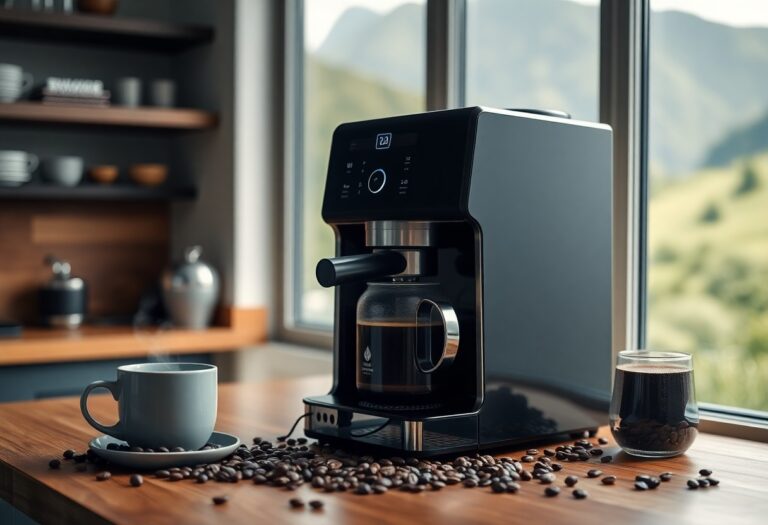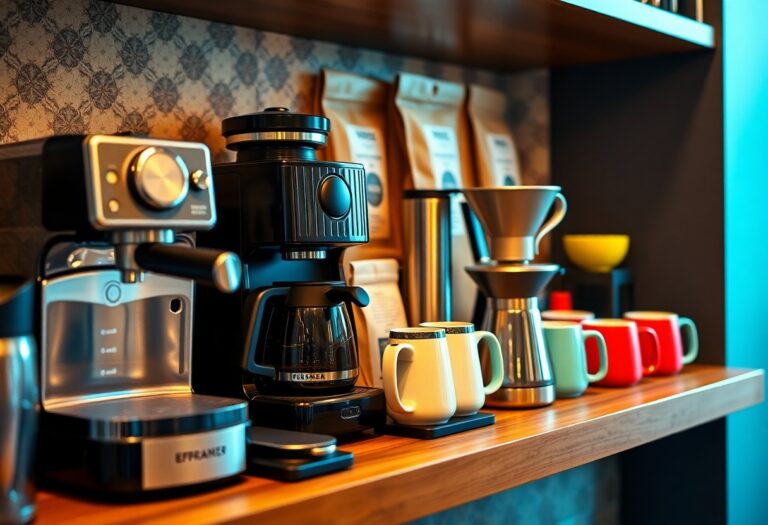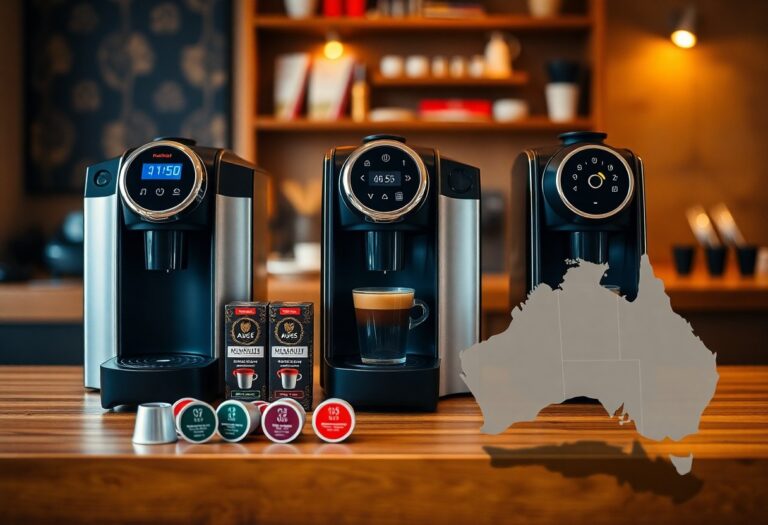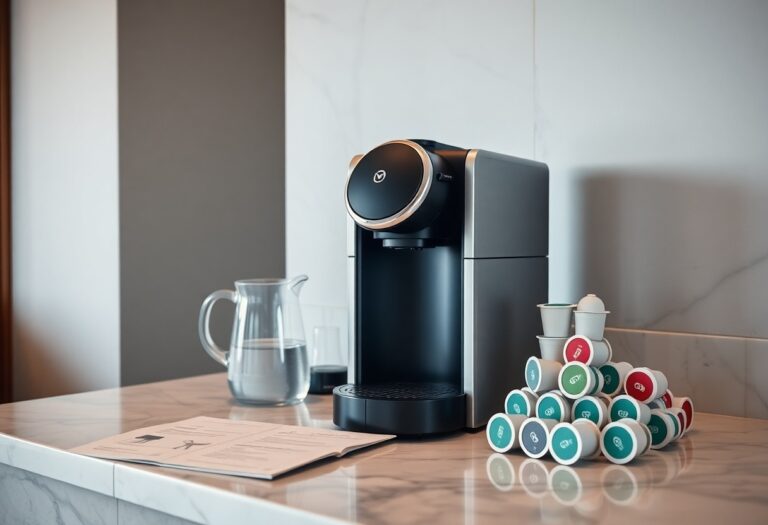What Coffee Do You Use in a Filter Coffee Machine – Filter Brewing
Many coffee enthusiasts wonder which type of coffee is best for their filter coffee machine. Choosing the right coffee can greatly enhance your brewing experience, allowing you to enjoy a delightful cup of joe. You’ll want to select freshly roasted coffee beans that suit your taste preferences, whether light, medium, or dark roast. Additionally, grind size matters—using a medium grind is often ideal for filter brewing. For more detailed insights, check out these Answers on how to make delicious filter coffee.

Key Takeaways:
- Choose medium to coarsely ground coffee for optimal extraction in filter coffee machines.
- Use freshly roasted coffee beans for the best flavor; aim for a roast date within a month.
- Consider the coffee-to-water ratio; a common guideline is 1 to 2 tablespoons of coffee per 6 ounces of water.
- Experiment with different coffee blends and origins to discover your preferred taste profile.
- Pay attention to water quality, as it significantly impacts the final flavor of your brew.

Selecting the Right Coffee Beans for Filter Brewing
Choosing the ideal coffee beans is the foundation of great filter brewing. Focus on beans with a balanced flavor profile that highlight the subtleties of the brewing method. Light to medium roast beans are often recommended, as they tend to retain the most nuanced flavors, while darker roasts can overshadow the delicate notes. Exploring single-origin coffees can also elevate your brew, providing a more personal and unique taste experience. By understanding the characteristics of various beans, you’ll elevate not only your filter coffee but also your appreciation for the artistry of coffee-making.
The Impact of Bean Origin on Flavor
Bean origin plays a significant role in determining the flavor profile of your coffee. Different countries and regions cultivate beans that develop unique characteristics due to varying climates, soil types, and processing methods. For instance, beans from Ethiopia are known for their bright, floral notes, while Colombian beans often exhibit a rich, nutty flavor. By experimenting with beans from various origins, you can discover what best suits your palate and enhances your filter brewing experience.
Freshness Matters: Why Roast Date Is Crucial
Freshly roasted beans make all the difference in flavor. Coffee begins to lose its peak taste within days of roasting, as the natural oils and volatile compounds that contribute to its aroma and flavor start to degrade. To fully appreciate the nuances of your chosen beans, opt for those roasted within the last two weeks. Packaging that features a roast date should be a priority when shopping, ensuring you enjoy coffee at its best.
Once coffee is roasted, the clock starts ticking on its freshness. Ideally, you want to brew your coffee within two weeks of the roast date for optimal flavor. After that, beans can begin to lose their vibrancy. Storing your coffee in an airtight container in a cool, dark place will help prolong its freshness, but nothing beats brewing with beans that have just reached their peak. For even greater quality, consider purchasing smaller batches of roasted beans more frequently, tailoring your supply to match your brewing schedule.
Grind Size: The Unsung Hero of Flavor Extraction
Achieving a balanced flavor in your filter coffee largely depends on the grind size of your beans. Each brewing method extracts flavor differently, and the size of your coffee grounds plays a significant role in this process. If your coffee is ground too fine or too coarse, it can lead to over-extraction or under-extraction, resulting in a brew that is either bitter or sour. Dialing in the right grind size ensures that your coffee achieves the desired richness and aromatic qualities, making this an often-overlooked but vital factor in filter brewing.
Matching Grind Size to Brewing Time
Ideally, your grind size should align with your brewing time to optimize extraction. For instance, a medium grind is often perfect for filter brewing methods that require a longer extraction time, such as pour-over or drip coffee, while a coarser grind suits quicker methods. Fine-tuning your grind to match the brewing time enhances flavor balance, ensuring a delightful cup every time.
How Grind Consistency Affects Your Brew
The consistency of your coffee grind can make or break your filter brewing experience. Uniformity in grind size allows for even extraction, ensuring that every particle contributes to the overall flavor profile. If some grounds are much finer than others, you’ll encounter a range of extraction levels — some may over-extract, leading to bitterness, while others under-extract, leaving your coffee lacking in depth.
Inconsistent grind can also lead to varying brew strengths. If your grinder produces an uneven mix of fine and coarse particles, you might face issues during brewing where some grounds dissolve too quickly while others take longer, creating an imbalanced and unpredictable flavor outcome. Investing in a good burr grinder ensures that your grind size is uniform—often resulting in a more flavorful and satisfying cup of coffee. Ultimately, consistency paves the way for precision in brewing, making your efforts worthwhile.
The Role of Coffee-to-Water Ratio in Taste
The coffee-to-water ratio is a fundamental aspect of filter brewing that directly influences your cup’s taste. This ratio determines how strong or weak your coffee will be, with common recommendations ranging from 1:15 to 1:18. Experimenting within this range allows you to achieve the perfect balance where the coffee’s nuanced flavors shine without becoming overpowering or bland.
Finding the Perfect Balance for Your Brew
To uncover the ideal coffee-to-water ratio for your brew, consider your personal taste preferences and the specific beans you’re using. A lighter roast may benefit from a slightly stronger ratio, while a darker roast often performs well with a more diluted mix. Adjusting these variables can enhance or mellow certain flavor notes, tailoring your experience to your liking.
Common Ratios and Their Flavor Profiles
Common coffee-to-water ratios include 1:15 for a robust flavor, 1:16 for a balanced cup, and 1:17 or 1:18 for a milder taste. Each ratio contributes distinct flavor profiles; for instance, a 1:15 ratio emphasizes richness and strength, ideal for bold palates, while a 1:18 ratio highlights subtlety, catering to those who enjoy nuanced tasting notes.
Exploring these common ratios can reveal the intricate differences in taste. A 1:15 ratio often creates a coffee that is vibrant and full-bodied, perfect for dark roasts. Conversely, a 1:17 ratio allows for a smoother, lighter cup that showcases the acidity and floral notes in medium roasts. By understanding these profiles, you can experiment with your brews and refine your coffee enjoyment according to your unique palate.
Brewing Techniques That Maximize Flavor
The way you brew coffee can significantly enhance its flavor profile, showcasing the full potential of your chosen beans. From water temperature to pre-infusion methods, dialing in these elements creates a richer, more aromatic experience. Exploring coffee’s complexity begins with understanding how each brewing technique interacts with your particular coffee type. By fine-tuning each aspect, you can unveil hidden notes and deepen your appreciation for your daily cup.
The Importance of Water Temperature
| Water Temperature | Effect on Extraction |
| 195°F – 205°F (90°C – 96°C) | Optimal for extracting flavors without bitterness. |
| Below 195°F | Possible under-extraction, resulting in a weak taste. |
| Above 205°F | Risk of over-extraction, introducing bitterness and off-flavors. |
Pre-Infusion: An Underutilized Step for Optimal Extraction
The pre-infusion technique allows you to bloom your coffee grounds before the full brew begins. This initial wetting releases carbon dioxide trapped in freshly roasted beans, enhancing flavor complexity. By allowing grounds to expand and evenly saturate, you prepare your coffee for an even extraction during brewing.
Implementing a pre-infusion step can elevate your coffee’s flavor dramatically. This process involves applying a small amount of hot water to your coffee grounds for about 30 seconds, letting them swell. During this time, the gases released create a more uniform extraction when you continue brewing, leading to a cup with heightened aroma and clarity. Not all coffee machines offer a dedicated pre-infusion feature, but you can easily adapt your brewing method by pouring water slowly and evenly over your grounds. This small investment of time pays off immensely, yielding a nuanced and delightful cup of coffee.
Common Mistakes That Sabotage Filter Coffee
Poor filter coffee can often stem from a few common mistakes that disrupt the brewing process. From using old coffee beans to incorrect grind sizes and imprecise water temperatures, these pitfalls can lead to a disappointing cup. Regularly assessing your brewing method and ingredients will help you identify these issues and improve your coffee-making skills. Avoiding these errors will ensure each cup is a true reflection of the coffee’s potential.
Over-Extracting vs. Under-Extracting: How to Avoid Both
Getting extraction just right is a balancing act, where over-extraction can lead to bitter flavors while under-extraction might leave your brew tasting sour. Aim for a brew time of around four to six minutes, adjusting based on your grind size; coarse grinds require longer times, while fine grinds will extract faster. Regularly taste your coffee and adjust parameters to dial in your ideal flavor profile.
Storage and Maintenance: Keeping Your Coffee Fresh
To keep your coffee tasting its best, a little attention to storage and maintenance goes a long way. Store your coffee beans in an airtight container away from light, moisture, and heat, ideally in a cool, dark place. Utilizing a dedicated coffee storage container can significantly prolong freshness. Avoid letting your opened bag sit on the shelf for weeks; aim to use the beans within two weeks for optimal flavor.
For extra freshness, consider grinding your coffee just before brewing. Whole beans maintain their flavor longer than pre-ground options, as they are less exposed to oxygen. Invest in a quality burr grinder to achieve an even and consistent grind. Also, it’s beneficial to clean your filter coffee machine regularly, at least once a month, to remove coffee oils and residue that may build up over time, ensuring each brew remains pure and flavorful.
Summing up
With these considerations, you can choose the right coffee for your filter coffee machine to enhance your brewing experience. Opt for a medium grind that complements your taste preferences and ensures optimal extraction. Select fresh, high-quality beans, whether single-origin or blends, to enrich your coffee’s flavor profile. Don’t overlook the importance of your brewing temperature and water quality, as they can significantly impact the outcome. By focusing on these aspects, you’ll be able to enjoy a satisfying cup of filter coffee tailored to your liking.
FAQ
Q: What type of coffee is best for filter brewing?
A: The best type of coffee for filter brewing is medium to coarsely ground coffee, which allows for optimal water flow and extraction. Look for a fresh, high-quality coffee bean, preferably a single-origin or freshly roasted blend. Coffee beans labeled as “filter roast” can also be an excellent choice since they are specifically processed for filter brewing methods.
Q: What grind size should I use for my filter coffee machine?
A: For filter coffee machines, a medium grind size is generally recommended. The ideal consistency is similar to granulated sugar, allowing for even extraction during the brewing process. If the grind is too fine, it can lead to over-extraction and a bitter taste, while too coarse a grind may result in under-extraction and a weak flavor.
Q: How much coffee should I use for each brew in a filter coffee machine?
A: A standard ratio for brewing coffee in a filter coffee machine is about 1 to 2 tablespoons of ground coffee for every 6 ounces of water. Adjust this to suit your taste preferences—more coffee for a stronger brew or less for a milder flavor. Keep in mind that different coffee beans and personal preferences can influence the ideal amount.
Q: Should I use filtered water for brewing filter coffee?
A: Yes, using filtered water is highly recommended for brewing filter coffee. Water quality greatly impacts the final taste of your coffee. Hard or tap water can impart unwanted flavors and impurities, affecting the overall brewing process. Filtered water reduces minerals and contaminants, leading to a cleaner, more enjoyable cup of coffee.
Q: How can I ensure the freshness of coffee used in my filter coffee machine?
A: To maintain coffee freshness, store your coffee beans in an airtight container in a cool, dark place, away from light, heat, and moisture. Grind your coffee just before brewing to maximize freshness. Additionally, purchase coffee in smaller batches to ensure you’re always using fresh beans, ideally within two weeks of roasting for the best flavor.







